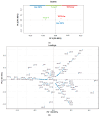Differentiation of Isomeric TAT1-CARNOSINE Peptides by Energy-Resolved Mass Spectrometry and Principal Component Analysis
- PMID: 40005164
- PMCID: PMC11858179
- DOI: 10.3390/molecules30040853
Differentiation of Isomeric TAT1-CARNOSINE Peptides by Energy-Resolved Mass Spectrometry and Principal Component Analysis
Abstract
L-carnosine (Car) is an endogenous dipeptide with significant potential in drug discovery for neurodegenerative diseases, while TAT1, a small arginine-rich peptide derived from the HIV-1 trans-activator protein (TAT), is known to stimulate proteasome activity. In this study, three isomeric peptides were synthesised by incorporating the Car moiety at the N-terminus, C-terminus, or central position of the TAT1 sequence. To differentiate these isomers, high-resolution and energy-resolved CID MS/MS experiments were conducted. The resulting MS/MS spectra showed a high degree of similarity among the peptides, predominantly characterised by fragment ion peaks arising from arginine-specific neutral losses. Energetic analysis was similarly inconclusive in resolving the isomers. However, Principal Component Analysis (PCA) enabled clear differentiation of the three peptides by considering the entire MS/MS spectra rather than focusing solely on precursor ion intensities or major fragment peaks. PCA loadings revealed distinct fragment ions for each peptide, albeit with lower intensities, providing insights into consecutive fragmentation patterns. Some of these specific peaks could also be attributed to scrambling during fragmentation. These results demonstrate the potential of PCA as a simple chemometric tool for semi-automated peak identification in complex MS/MS spectra.
Keywords: MS/MS; Principal Component Analysis; TAT1; carnosine; energy-resolved mass spectrometry; high-resolution mass spectrometry; isomeric peptides.
Conflict of interest statement
The authors declare no conflicts of interest.
Figures












References
MeSH terms
Substances
LinkOut - more resources
Full Text Sources

